1.4: Chapter 1 Review Exercises
- Page ID
- 66283
Chapter Review Exercises
Graph Linear Equations in Two Variables
Plot Points in a Rectangular Coordinate System
In the following exercises, plot each point in a rectangular coordinate system.
1. ⓐ \((−1,−5)\)
ⓑ \((−3,4)\)
ⓒ \((2,−3)\)
ⓓ \((1,\frac{5}{2})\)
- Answer
-
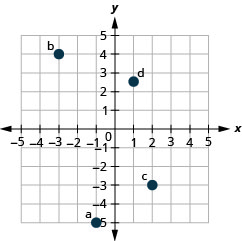
2. ⓐ \((−2,0)\)
ⓑ \((0,−4)\)
ⓒ \((0,5)\)
ⓓ \((3,0)\)
In the following exercises, determine which ordered pairs are solutions to the given equations.
3. \(5x+y=10\);
ⓐ \((5,1)\)
ⓑ \((2,0)\)
ⓒ \((4,−10)\)
- Answer
-
ⓑ, ⓒ
4. \(y=6x−2\);
ⓐ \((1,4)\)
ⓑ \((13,0)\)
ⓒ \((6,−2)\)
Graph a Linear Equation by Plotting Points
In the following exercises, graph by plotting points.
5. \(y=4x−3\)
- Answer
-
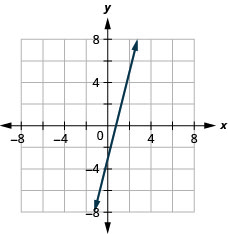
6. \(y=−3x\)
7. \(y=\frac{1}{2}x+3\)
- Answer
-
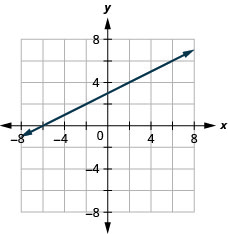
8. \(y=−\frac{4}{5}|x−1\)
9. \(x−y=6\)
- Answer
-
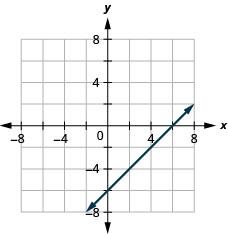
10. \(2x+y=7\)
11. \(3x−2y=6\)
- Answer
-
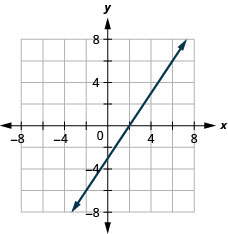
Graph Vertical and Horizontal lines
In the following exercises, graph each equation.
12. \(y=−2\)
13. \(x=3\)
- Answer
-
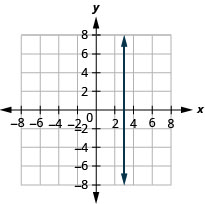
In the following exercises, graph each pair of equations in the same rectangular coordinate system.
14. \(y=−2x\) and \(y=−2\)
15. \(y=\frac{4}{3}x\) and \(y=\frac{4}{3}\)
- Answer
-
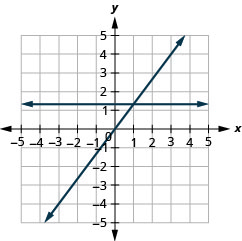
Find x- and y-Intercepts
In the following exercises, find the x- and y-intercepts.
16.
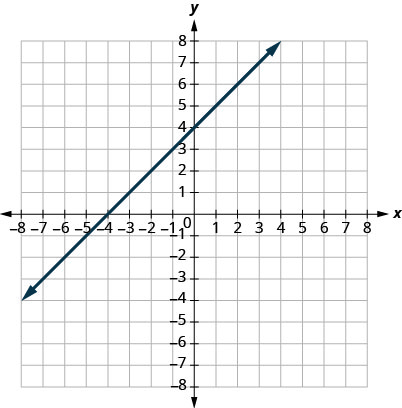
17.
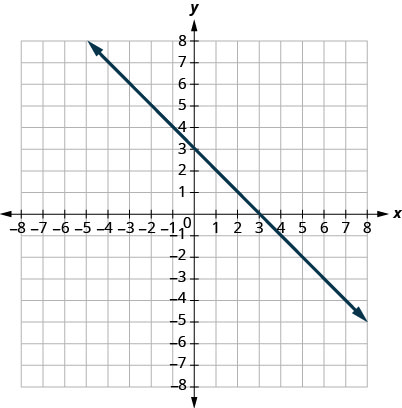
- Answer
-
\((0,3)(3,0)\)
In the following exercises, find the intercepts of each equation.
18. \(x−y=−1\)
19. \(x+2y=6\)
- Answer
-
\((6,0),\space (0,3)\)
20. \(2x+3y=12\)
21. \(y=\frac{3}{4}x−12\)
- Answer
-
\((16,0),\space (0,−12)\)
22. \(y=3x\)
Graph a Line Using the Intercepts
In the following exercises, graph using the intercepts.
23. \(−x+3y=3\)
- Answer
-
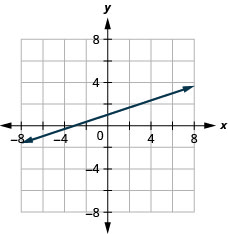
24. \(x−y=4\)
25. \(2x−y=5\)
- Answer
-

26. \(2x−4y=8\)
27. \(y=4x\)
- Answer
-
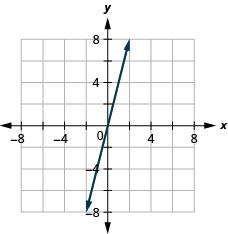
Slope of a Line
Find the Slope of a Line
In the following exercises, find the slope of each line shown.
28.
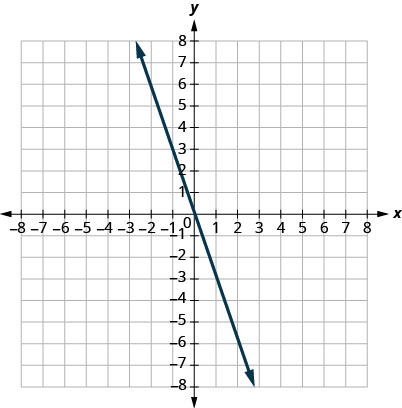
29.
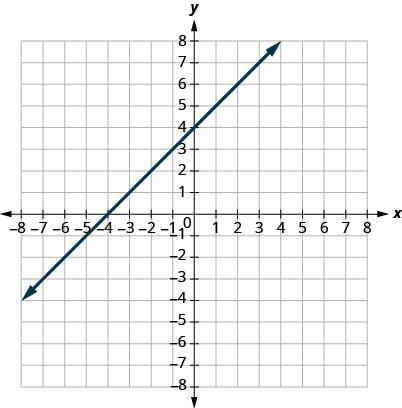
- Answer
-
1
30.
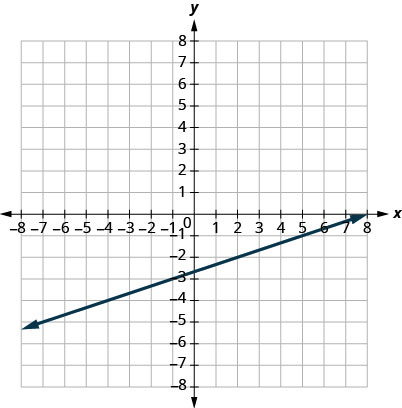
31.
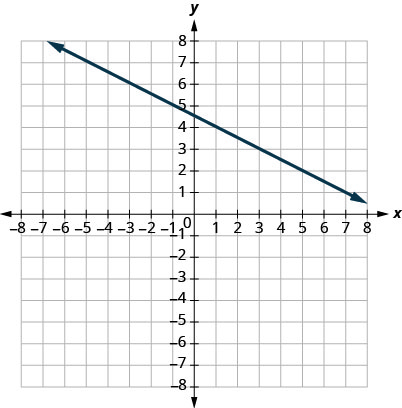
- Answer
-
\(−12\)
In the following exercises, find the slope of each line.
32. \(y=2\)
33. \(x=5\)
- Answer
-
undefined
34. \(x=−3\)
35. \(y=−1\)
- Answer
-
0
Use the Slope Formula to find the Slope of a Line between Two Points
In the following exercises, use the slope formula to find the slope of the line between each pair of points.
36. \((−1,−1),(0,5)\)
37. \((3.5),(4,−1)\)
- Answer
-
\(−6\)
38. \((−5,−2),(3,2)\)
39. \((2,1),(4,6)\)
- Answer
-
\(52\)
Graph a Line Given a Point and the Slope
In the following exercises, graph each line with the given point and slope.
40. \((2,−2);\space m=52\)
41. \((−3,4);\space m=−13\)
- Answer
-
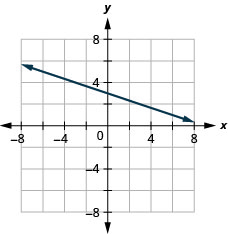
42. \(x\)-intercept \(−4; m=3\)
43. \(y\)-intercept \(1; m=−34\)
- Answer
-
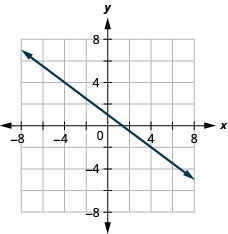
Graph a Line Using Its Slope and Intercept
In the following exercises, identify the slope and \(y\)-intercept of each line.
44. \(y=−4x+9\)
45. \(y=53x−6\)
- Answer
-
\(m=53;\space (0,−6)\)
46. \(5x+y=10\)
47. \(4x−5y=8\)
- Answer
-
\(m=45;\space (0,−85)\)
In the following exercises, graph the line of each equation using its slope and y-intercept.
48. \(y=2x+3\)
49. \(y=−x−1\)
- Answer
-
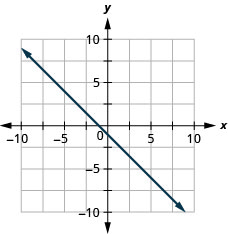
50. \(y=−25x+3\)
51. \(4x−3y=12\)
- Answer
-
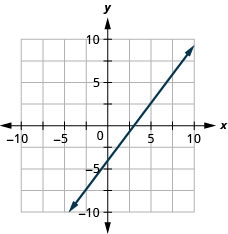
In the following exercises, determine the most convenient method to graph each line.
52. \(x=5\)
53. \(y=−3\)
- Answer
-
horizontal line
54. \(2x+y=5\)
55. \(x−y=2\)
- Answer
-
intercepts
56. \(y=22x+2\)
57. \(y=34x−1\)
- Answer
-
plotting points
Graph and Interpret Applications of Slope-Intercept
58. Katherine is a private chef. The equation \(C=6.5m+42\) models the relation between her weekly cost, C, in dollars and the number of meals, m, that she serves.
ⓐ Find Katherine’s cost for a week when she serves no meals.
ⓑ Find the cost for a week when she serves 14 meals.
ⓒ Interpret the slope and C-intercept of the equation.
ⓓ Graph the equation.
59. Marjorie teaches piano. The equation \(P=35h−250\) models the relation between her weekly profit, P, in dollars and the number of student lessons, s, that she teaches.
ⓐ Find Marjorie’s profit for a week when she teaches no student lessons.
ⓑ Find the profit for a week when she teaches 20 student lessons.
ⓒ Interpret the slope and P-intercept of the equation.
ⓓ Graph the equation.
- Answer
-
ⓐ \(−$250\)
ⓑ \($450\)
ⓒ The slope, 35, means that Marjorie’s weekly profit, P, increases by $35 for each additional student lesson she teaches.
The P-intercept means that when the number of lessons is 0, Marjorie loses $250.
ⓓ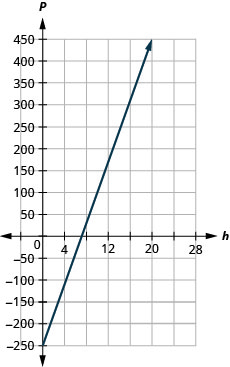
Use Slopes to Identify Parallel and Perpendicular Lines
In the following exercises, use slopes and \(y\)-intercepts to determine if the lines are parallel, perpendicular, or neither.
60. \(4x−3y=−1;\quad y=43x−3\)
61. \(y=5x−1;\quad 10x+2y=0\)
- Answer
-
neither
62. \(3x−2y=5;\quad 2x+3y=6\)
63. \(2x−y=8;\quad x−2y=4\)
- Answer
-
not parallel
Find the Equation of a Line
Find an Equation of the Line Given the Slope and y-Intercept
In the following exercises, find the equation of a line with given slope and y-intercept. Write the equation in slope–intercept form.
64. Slope \(\frac{1}{3}\) and \(y\)-intercept \((0,−6)\)
65. Slope \(−5\) and \(y\)-intercept \((0,−3)\)
- Answer
-
\(y=−5x−3\)
66. Slope \(0\) and \(y\)-intercept \((0,4)\)
67. Slope \(−2\) and \(y\)-intercept \((0,0)\)
- Answer
-
\(y=−2x\)
In the following exercises, find the equation of the line shown in each graph. Write the equation in slope–intercept form.
68.
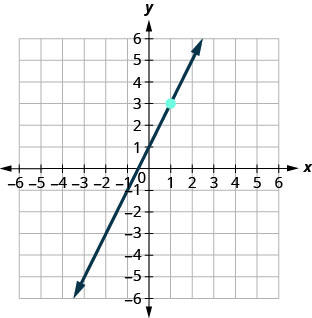
69.
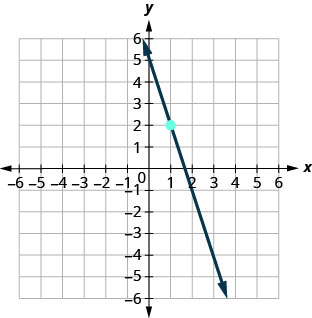
- Answer
-
\(y=−3x+5\)
70.
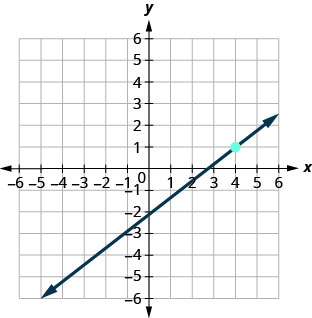
71.

- Answer
-
\(y=−4\)
Find an Equation of the Line Given the Slope and a Point
In the following exercises, find the equation of a line with given slope and containing the given point. Write the equation in slope–intercept form.
72. \(m=−\frac{1}{4}\), point \((−8,3)\)
73. \(m=\frac{3}{5}\), point \((10,6)\)
- Answer
-
\(y=\frac{3}{5}x\)
74. Horizontal line containing \((−2,7)\)
75. \(m=−2\), point \((−1,−3)\)
- Answer
-
\(y=−2x−5\)
Find an Equation of the Line Given Two Points
In the following exercises, find the equation of a line containing the given points. Write the equation in slope–intercept form.
76. \((2,10)\) and \((−2,−2)\)
77. \((7,1)\) and \((5,0)\)
- Answer
-
\(y=\frac{1}{2}x−\frac{5}{2}\)
78. \((3,8)\) and \((3,−4)\)
79. \((5,2)\) and \((−1,2)\)
- Answer
-
\(y=2\)
Find an Equation of a Line Parallel to a Given Line
In the following exercises, find an equation of a line parallel to the given line and contains the given point. Write the equation in slope–intercept form.
80. line \(y=−3x+6\), point \((1,−5)\)
81. line \(2x+5y=−10\), point \((10,4)\)
- Answer
-
\(y=−\frac{2}{5}x+8\)
82. line \(x=4\), point \((−2,−1)\)
83. line \(y=−5\), point \((−4,3)\)
- Answer
-
\(y=3\)
Find an Equation of a Line Perpendicular to a Given Line
In the following exercises, find an equation of a line perpendicular to the given line and contains the given point. Write the equation in slope–intercept form.
84. line \(y=−\frac{4}{5}x+2\), point \((8,9)\)
85. line \(2x−3y=9\), point \((−4,0)\)
- Answer
-
\(y=−\frac{3}{2}x−6\)
86. line \(y=3\), point \((−1,−3)\)
87. line \(x=−5\) point \((2,1)\)
- Answer
-
\(y=1\)
Practice Test
1. Plot each point in a rectangular coordinate system.
ⓐ \((2,5)\)
ⓑ \((−1,−3)\)
ⓒ \((0,2)\)
ⓓ \((−4,32)\)
ⓔ \((5,0)\)
- Answer
-
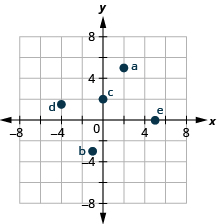
2. Which of the given ordered pairs are solutions to the equation \(3x−y=6\)?
ⓐ \((3,3)\) ⓑ \((2,0)\) ⓒ \((4,−6)\)
3. Find the slope of each line shown.
ⓐ
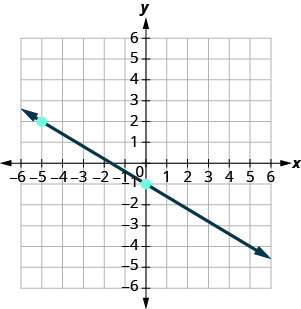
ⓑ
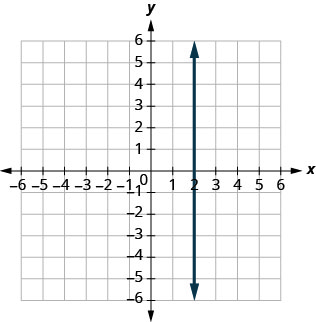
- Answer
-
ⓐ \(−\frac{3}{5}\) ⓑ undefined
4. Find the slope of the line between the points \((5,2)\) and \((−1,−4)\).
5. Graph the line with slope \(\frac{1}{2}\) containing the point \((−3,−4)\).
- Answer
-
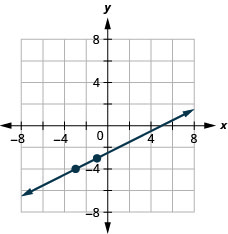
6. Find the intercepts of \(4x+2y=−8\) and graph.
Graph the line for each of the following equations.
7. \(y=\frac{5}{3}x−1\)
- Answer
-
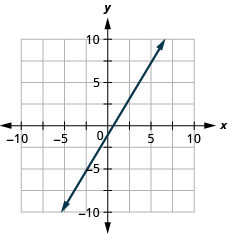
8. \(y=−x\)
9. \(y=2\)
- Answer
-
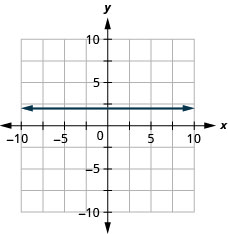
Find the equation of each line. Write the equation in slope-intercept form.
10. slope \(−\frac{3}{4}\) and \(y\)-intercept \((0,−2)\)
11. \(m=2\), point \((−3,−1)\)
- Answer
-
\(y=2x+5\)
12. containing \((10,1)\) and \((6,−1)\)
13. perpendicular to the line \(y=\frac{5}{4}x+2\), containing the point \((−10,3)\)
- Answer
-
\(y=−\frac{4}{5}x−5\)

